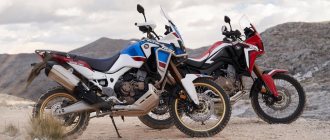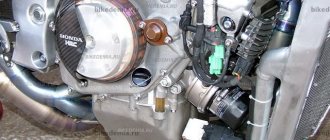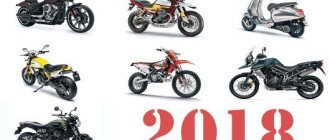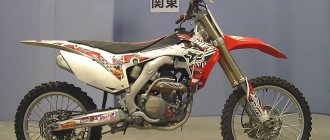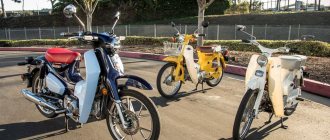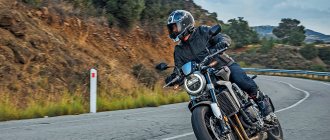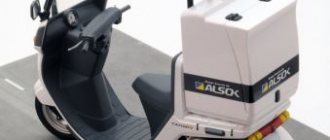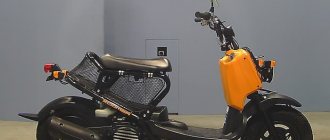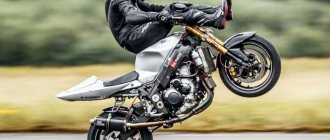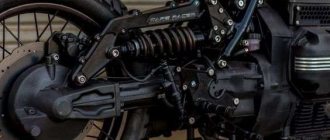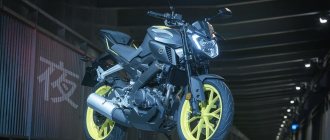The name of the new Honda CB1000R Neo Sports Cafe naked is not easy to remember - it seems as if these are three different versions of the same model. But, having gotten to know him better, you understand: every word is justified. It remains only to understand which of them determines the character of the motorcycle more than others
Neoclassics, which came into fashion several years ago, is in no hurry to give way to new trends and only clings more tightly to the minds and hearts of motorcycle designers. Round headlights, brushed aluminum, here and there a sneaking nod to the “old school” - this is what the “suits” for roadsters are made of today. It is not surprising that Honda chose a neoclassical style for the motorcycle that replaced the previous generation CB1000R, produced since 2008, which is emphasized in the name of the new product.
Bike features
Here are the advantages of the Honda SB 1000 R:
- high dynamic performance for the class on a good road;
- good motorcycle handling even at high speeds;
- The seat is comfortable for the back, which allows you to ride for a long time in comfort.
The bike is a fairly powerful model, which is in no way suitable for an inexperienced driver. It is too aggressive in its speed parameters, despite the fact that the torque is smoothed out and the car does not jerk when accelerating.
Test drive HondaCB 1000R
When two years ago I came across the “almost liter” Hornet CB900F, I, despite my indifferent attitude towards sports and street racing, was literally captivated by it. Comfortable to sit on, with a groovy and incredibly tractable injection engine, it didn’t let me get bored either in the city crowd or on the highway.
You can imagine with what interest I went on a “date” with its successor, a completely new motorcycle, which, in the short time since its debut at the end of the summer of 2008, managed to “make a splash” in all European markets, greatly squeezing out its competitors .
The appearance of the motorcycle immediately attracts attention (the main attraction is the headlight), captivating with its unusualness, and can leave only old ladies indifferent. Tested - during 15 minutes of parking in the city center, everyone who passed by at least turned their head and slowed down (if not stopped at all to take a closer look at the “object”).
Oddly enough, sitting on the triangular seat turned out to be not at all as extreme as thought: the hands clasped the steering wheel handles, the feet stood on the footrests, the knees rested comfortably in the recesses of the tank, and the “fifth point” rested against the ledge of the passenger seat. At the same time, there is no tension in the back, characteristic of a sportbike landing. It’s also impossible to call it classically straight, since there is a slight slope towards the gas tank, but I can say for sure that even for my height it turned out to be quite comfortable.
The only thing that reminds us of its kinship with a sportbike is the support for the “fifth point”, which is the raised passenger seat during sharp accelerations. By the way, about the passenger. Its “perch” was apparently specially made so narrow and uncomfortable (add here the complete absence of any handles) so that there would be no desire to ride for a long time and thereby interfere with the pilot’s enjoyment of the motorcycle.
And there is a lot to enjoy here. Despite the fact that the engine from the CBR1000RR sportbike (2007 model) was severely “strangled”, taking away its entire population of “horses”, it was not deteriorated at all, since the characteristics were made as suitable as possible for use in the “natural” habitat of streetfighters - the city. The first thing that strikes you as soon as you get underway is the incredible traction. If desired, I calmly started from second gear, practically without touching the throttle. You don’t always even want to start moving from first gear because of the too loud, I would even say frightening, “clack!” sound. when you turn it on. In the rest of the range, the gearbox (Honda - forever!) works so softly and clearly that you don’t even notice how easily you get to the highest, sixth gear, without ever pushing the bar on the liquid crystal tachometer scale past the 5000 rpm mark (break-in, after all ). “So what?” you ask sarcastically. Yes, the fact of the matter is that there is NOTHING (unpleasant). Such as engine jerking in convulsions, transmission clunking and other signs of lack of power. Little of! You may not believe me, but very confident acceleration begins from 4000 rpm. It should be noted that this motor showed simply miracles of elasticity in an experiment conducted by our colleagues from the UK (when accelerating in 6th gear from 40 to 120 mph (from 64 to 192 km/h, respectively) showing time 13.05 s For comparison: Yamaha FZ1 - 16.65 s; Aprilia Tuono - 18.6 s.
After driving around the city a little, I finally got into a traffic jam and drove along the aisle in second gear, completely “dulling” the throttle, that is, at idle. The tachometer showed only 1700 rpm, but the motorcycle rode quite confidently. But “vomiting” between the rows is a forced situation, but the greatest pleasure is the liter “SiBiha” (by the way, for some reason the Japanese, unlike the “six hundred”, deprived of the usual name “Hornet”) can deliver on wide streets and prospectuses. Thanks to the short wheelbase and optimal weight distribution (49/51), the motorcycle steers, as they say, “by the power of thought” and shifting it in slalom between cars moving orderly in rows works great. At first I thought that on the “clumsy” Kiev asphalt there would be problems with depreciation - after all, the suspension travel of this streetfighter is like that of a sportbike, but even the factory settings turned out to be quite enough for them to completely absorb most of the irregularities and, in general, during the test, they did not cause any complaints. The sample we tested was equipped with ABS (this is an option). To be honest, at the beginning of the test it was not entirely clear to me why a streetfighter needed an anti-lock brake system, but then I realized: Honda designers sought to make the CB1000R as friendly as possible to a novice pilot (without detracting from its advantages), and this motorcycle is that rare, but there is a very real opportunity to start your motorcycle life with a “liter” (if, of course, finances allow) and then the presence of ABS will definitely not be superfluous. But in general, the brakes can be rated as “five”, since the information content of the braking process is high even in the absence of reinforced hoses, and the ABS system intervenes in the process at the very end and in most cases you can do without it. For obvious reasons, I did not conduct tests to achieve maximum speed, but I can assure you: this parameter is not so important for this specimen, which is quite capable of “getting over two hundred,” especially since after 170 km/h without leaning on the tank it can be maintained at this naked it becomes difficult.
An interesting “trick” was discovered at a gas station: along the filler neck there is a rod that prevents even a “narrow-nosed” pistol from being inserted into the tank, so you have to hold it with your hand during the entire process. It was not possible to find out what this is connected with, but this “device” reduces the convenience of refueling. That seems to be it... No, wait, I forgot about two important points: the headlight on the CB1000R is not just breathtakingly beautiful, it also illuminates the road surface quite well. And its LED “gun”, which shines with blue light, helps clear the way in clusters of “tin cans”. The fully digital instrument panel is also interesting, although, as for me, at least the tachometer should still be analog - its readability is an order of magnitude higher.
I can state that, although the Japanese deprived the new CB1000R of the now familiar “Hornet” name, in return they gave it so many positive things that such a replacement can be considered adequate with one hundred percent certainty.
Opinion: Vladislav Sofonov
Height: 180 cm. Weight: 75 kg
Driving experience: 8 years
Rides a Kawasaki ER-5
When you see a liter bike flying past you, sometimes it seems that this is the ultimate dream. But you still have to grow and grow and gain experience. Otherwise, you never know... Suddenly, more than a hundred horses hidden in the engine of such a “monster” will take you and throw you out of the saddle. But when I sat in the saddle of the Honda CB1000R, it seemed to me that a friendlier “liter” simply did not exist.
From the first seconds of conversation, the engine captivated me with its simply amazing elasticity. The first comparison that flashed in my head was a comparison with the engine of the Honda Valkyrie Rune 1800. The derated engine from the 2007 Fireblade superbike, installed in the chassis of this bright streetfighter, had almost the same, as it seemed to me, “locomotive” thrust as the boxer 6-cylinder megacruiser engine. But his former sporting character has not disappeared anywhere. And as soon as the clutch was depressed, the gas was sharply opened, and the engine literally howled, instantly spinning up to maximum speed. With such an engine you definitely won't get bored. But I won’t intimidate anyone and will say right away that on the road he was as obedient as a tame animal. And for this you didn’t even have to delicately handle the throttle. After the first hundred meters, my initial caution disappeared without a trace: I felt that without my permission this motorcycle would not make a single unnecessary movement and the front wheel would not suddenly fly into the air.
Dosing gas is extremely easy: the handle stroke is large enough for this, and the reverse resistance is selected so as not to accidentally unscrew the handle more than normal. Thanks to the engine's high elasticity, you don't have to worry about what gear is currently engaged. In the city you can cruise with equal ease in second or fifth gear without shifting for a long time. And even in the latter case, the engine thrust will always be enough. The reason is that the Fireblade engine was not only derated (reducing the maximum power from 175 to 125 hp, while saturating the low and middle speed ranges), but also changed the gear ratios in the transmission, limiting the “maximum speed” at 220+ km/h .
As the bike's design engineer said, "You never get 100 percent performance out of a superbike, but the CB1000R lets you do that!" And he's right. No racing skills are required to operate the CB1000R. Only a certain level of training is enough to feel confident on a motorcycle. And then the motorcycle really allows you to use all its capabilities and all its power.
Of course, some safety net will not be superfluous, and Honda has remained true to its traditions in this regard. Honda wouldn't be itself if it didn't offer the CB1000R with C-ABS (combined braking system + ABS). And I must say that this system on a motorcycle does not seem superfluous at all. The CB1000R comes standard with 4-piston radial brake calipers at the front, but the C-ABS version features 3-piston floating calipers. But it didn’t seem to me that they brake worse than radial ones. When braking, this motorcycle simply bites into the asphalt and can easily make a stop.
The motorcycle’s suspension seems a bit harsh at first – apparently, it’s calibrated for active riding. But this does not prevent it from quietly swallowing small potholes. In addition, the set of fork and rear shock settings is sufficient to calibrate it according to your own preferences. True, the ground clearance could have been higher - you can’t move off the edge on the CB1000R, and you have to drive through every speed bump with caution so as not to catch it with the muffler pipes.
I had no complaints regarding the handling of the motorcycle. As I already said, this “liter” is very friendly, and therefore obeys the driver in everything. And the “streetfighter” style imposes on the motorcycle the obligation to be nimble and agile, both in the city and beyond. Even when I felt like I was too fast to get into a particular corner, the CB1000R didn't get intimidated and easily did what it thought it couldn't do. I didn’t even strain myself.
It would seem: the perfect motorcycle! But we, the insidious “journalists,” know that such things do not exist. And therefore we are always looking for something to complain about and are very happy if we find it. So I found that this motorcycle does not have a very comfortable seat for a person of my build. In appearance it seems flat, and, “strangely enough,” the “fifth point” feels exactly the same way. You can fidget around for a long time and not find the optimal position. True, I only noticed this when I returned the motorcycle to the dealership. Apparently, the rest of the time I was not at all in the mood to notice any little things - communication with this Honda CB1000R was so pleasant.
Text: Valera DRIVE
Photo: Andrey Shlenchak
The motorcycle was provided for testing to the official distributors of Honda in Ukraine.
Dimensions and weight
The motorcycle reaches 2105 mm in length, 785 mm in width, and 1095 mm in height. Its height at the saddle is 825 mm, and the wheelbase reaches 1445 mm. Not counting fuel, this model weighs 217 kg, and the tank volume is 17 liters. On average, approximately 4.9 liters of gasoline will be consumed per 100 km of road.
Brief history of the model
- 2008 - start of production and sales. First generation
.
Model:
Honda CB1000R (Europe, Oceania).
Model code
: CB1000R8.
- 2009 - no significant changes.
Model:
Honda CB1000R / CB1000R (ABS) (Europe, Oceania).
Frame number:
ZDC
SC60A
XXXXXXXXXXX, ZDC
SC60C
XXXXXXXXXXX - UK, Europe;
ZDC SC60B
XXXXXXXXXXX, ZDC
SC60D
XXXXXXXXXXX - France;
ZDC SC60U
XXXXXXXXXXX - Oceania.
Model code:
CB1000RA / CB1000RAA.
- 2010 - no significant changes.
Model:
Honda CB1000R + ABS (Europe, Oceania).
Frame number:
ZDC
SC601B
XXXXXXXXXX.
Model code:
CB1000RA / CB1000RAA.
- 2011 - no significant changes.
Model:
Honda CB1000R + ABS (North America, Europe).
Frame number:
ZDC
SC601C
XXXXXXXXXX.
Model code:
CB1000RB + CB1000RAB.
- 2012 - no significant changes.
Model:
Honda CB1000R + ABS (North America, Europe).
Frame number:
ZDC
SC601D
XXXXXXXXXX.
Model code:
CB1000RC + CB1000RAC.
- 2013 - no significant changes.
Model:
Honda CB1000R + ABS (North America, Europe).
Frame number:
ZDC
SC605E
XXXXXXXXXX, ZDC
SC601E
XXXXXXXXXX.
Model code:
CB1000RD + CB1000RAD.
- 2014 - no significant changes.
Model:
Honda CB1000R + ABS (North America, Europe).
Model code:
CB1000RE + CB1000RAE.
- 2015 - no significant changes.
Model:
Honda CB1000R + ABS (North America, Europe).
Model code:
CB1000RF + CB1000RAF.
- 2016 - no significant changes.
Model:
Honda CB1000R + ABS (North America, Europe).
Model code:
CB1000RF + CB1000RAF; CB1000RG.
- 2017 - no significant changes.
Model:
Honda CB1000R ABS (Europe).
Model code:
CB1000RAF.
- 2018 - restyling of the model. Second generation
. The model receives a new appearance, a redesigned engine (increased compression ratio, maximum power increases to 145 hp), traction control system with three operating modes, electronic throttle, slipper clutch with an assistant, ABS in the basic version (without combination brakes) , reduced fuel tank (from 17 to 16.2 l), cable-operated clutch (instead of hydraulics) and lower curb weight (212 kg).
Model:
Honda CB1000R ABS (Europe, North America, Oceania).
Model code:
CB1000RAJ.
- 2019 - no significant changes.
Model:
Honda CB1000R ABS (Europe, North America, Oceania).
Model code:
CB1000RAK.
- 2020 - no significant changes.
Model:
Honda CB1000R ABS (Europe, North America, Oceania).
Model code:
CB1000RAL.
- 2021 - no significant changes.
Model:
Honda CB1000R ABS (Europe, North America, Oceania).
Model code:
CB1000RAM.
Chassis and brakes
The frame of this machine is made of aluminum, which is not surprising considering how it positions itself. Of course, the wheels here are alloy, and by the way, they look very stylish. The steering wheel has standard dimensions for the class and is unremarkable.
The rear suspension is a cantilever pendulum version with a monoshock absorber. At the front it is an inverted fork with dimensions of 43 mm. For such a motorcycle this option is quite acceptable. Braking at the rear is a 256mm disc along with a two-piston caliper, while at the front there are a pair of 310mm discs with four-piston calipers.
Eh, I'll take a ride!
The word cafe in the name also reminds us of the design – the new CB1000R also contains a reference to the glorious era of British cafe racers. This includes a chopped tail with a minimalist rear light in the form of an LED semicircle, a semi-sporty riding position, and most importantly, original accessories, for example, a tiny fairing above the dashboard and a cover that replaces the passenger saddle and turns a two-seater motorcycle into a single-seater. The catalog of factory tuning is generally wide - Honda understands how important it is for motorcyclists to be able to “tailor” the device to suit themselves.
As for the word sport, here too there is no need to talk about a simple marketing ploy; the power unit of the new product, as is usual with the world's largest manufacturers, has been transferred to the road motorcycle from the flagship sportbike. In this case, the “donor” of the unit was the CBR1000, although on the way from one model to another the engine underwent a number of changes, lost peak power and torque values in the upper speed range, but gained strength in the lower and middle.
Together with the changed gearbox, gear ratios became 4% shorter than sportbike ones, while the acceleration dynamics turned out to be more vigorous, at least up to 130 km/h. And the fact that the maximum speed turned out to be lower, on a motorcycle without a fairing, even exchanging the second “hundred” is a dubious pleasure, and at 240 km/h the air presses so much that it’s difficult to breathe.
In other words, the remaining “herd” of 146 hp. ample for a reasonable 212kg curb weight. Inexplicable, but true: engineers managed to reduce the weight of the new CB1000R Neo Sports Cafe by 8 kg compared to its predecessor, abandoning the aluminum frame in favor of a steel one. More precisely, now it is a half-frame - a ridge made of a rectangular pipe ends at the pendulum, and the saddle is already attached to an aluminum subframe.
The engineers succeeded in the new chassis: the frame, coupled with high-quality suspensions, is resistant to torsion and behaves amazingly even in very deep turns. The updated inverted fork has separate adjustment: a screw on the right shock absorber is responsible for spring preload, while a pair of screws on the left shock absorber adjust the hydraulic stiffness. However, there was no desire to change the factory settings of the fork, but the rear suspension seemed too soft.
The adjustment saves only partly; the cantilever pendulum with the license plate bracket, as well as the wheel size 190/55/17, are bright and stylish solutions, but no one has canceled the side effect in the form of growing unsprung masses. In any case, you won’t have to complain about them often; things are going too well with everything else.
We were pleased with the brakes: a pair of grippy monoblock 4-piston calipers with radial mount not only effectively settle the motorcycle, but also do not annoy the excessively early activation of ABS. And during sudden decelerations, the electronics also turn on the emergency lights, warning other road users of potential danger.
